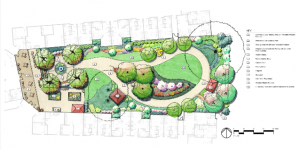
Submitted by SCJ Alliance
Better sleep. Reduced aggression. Shorter hospital stays. Reduced need for pain medication. An 84 percent drop in hip fractures.
These may sound like the promises of a drug company or an overeager fitness nut, but one thing that has been linked to all these benefits is free, easy and accessible to everyone: The Great Outdoors.

SCJ’s landscape architecture team has long understood the nurturing aspect of Mother Nature and recently sent one team member to Chicago for an intensive, eight-day professional development course on therapeutic landscapes.
“It’s a consideration that will add value to any facility, new or existing, that incorporates care,” said Miranda Estes, landscape architect at SCJ. “Hospitals, schools and senior living centers can all realize significant benefits from this kind of thinking,” she said, noting she recently worked on a therapeutic garden for a memory care facility under construction in Olympia.
These intentionally designed garden environments maximize the effectiveness of clinical treatments for illness and disabilities, reduce staff stress and absenteeism, improve patient health, increase client satisfaction, and strengthen the bottom line.
At the pioneering Martin Luther Alzheimer Garden in Michigan, nursing records were examined for eight variables: aggressive and nonaggressive behavior, physician-ordered and as-needed medications, pulse rate, diastolic and systolic blood pressure and weight change. When these variables were compared to the amount of time people spent outside, residents showed significant improvements on virtually every parameter with as little as 10 to 15 minutes of programmed outdoor activity per day.
“Even a small amount of time outside has been linked with dramatic improvements in patient health, and providing a safe and inviting place for that to happen can lead to noticeable savings,” Miranda said.

A 2003 study found that elderly stroke patients who received as little as 15 minutes of sunlight per day had 84 percent fewer hip fractures than those who were not regularly exposed to sunlight. A separate study showed women 50 years or older who gardened at least once a week had higher bone density readings than those who walk, jog, swim or do aerobics. The weight-bearing motions like pulling weeds, turning soil and pushing a wheelbarrow build strong bone and muscle and improve overall balance.
Studies have also shown better sleep patterns and reduced aggression among Alzheimer’s and dementia patients after they spent a short time each day outside in natural light. Such changes can lead to lower costs in staff time, both during the day and night, and a smaller demand for medications.
“Staff can benefit from access to therapeutic landscapes on many levels,” Miranda added, and some studies show that gardens in hospitals are predominantly used by staff.
“Healthcare is stressful not only for the customer, but also for the provider,” she said. “Stress and burnout lead to high turnover. So, it is worthwhile to consider how a garden might assist in improving staff health, satisfaction, and retention.”
From a marketing standpoint, quality outdoor space is a powerful selling feature that evokes a sense of peace and normalcy for prospective residents at retirement communities. Gardens and outdoor living areas become the backdrop of marketing materials and family decisions on where their loved ones should live.

“It is imperative we start this conversation early in the project planning process,” Miranda said. “Even decisions like siting the building and placing doors and windows can affect usability and access for differently-abled patients. A person is much more likely to use a garden if they can see it, if they know it’s within reach.”
SCJ Senior Vice President Jean Carr said, “We are always looking for ways to better serve our clients, and incorporating therapeutic landscape design is a smart, cost-effective way for our clients to do the same for theirs.”




















































